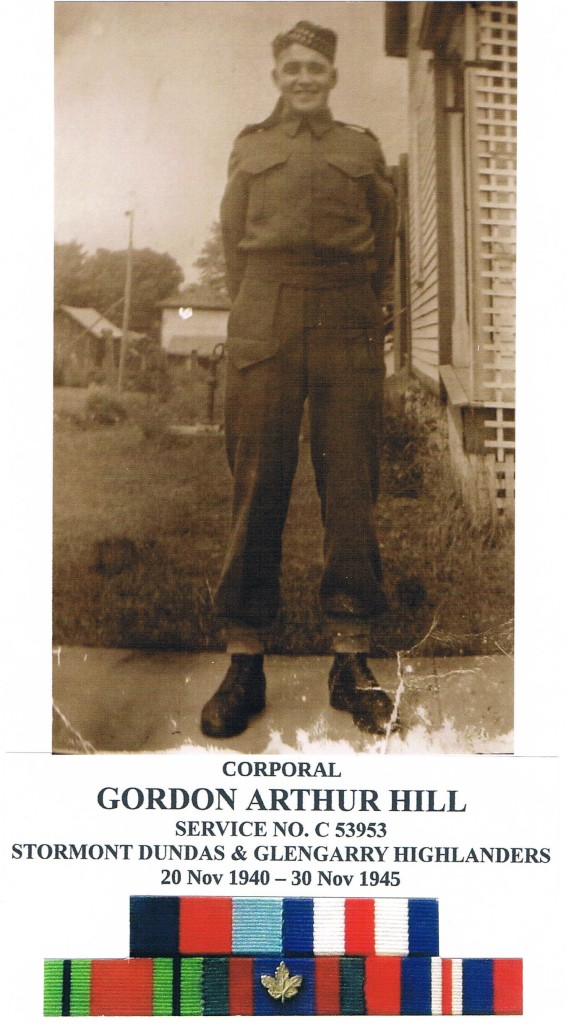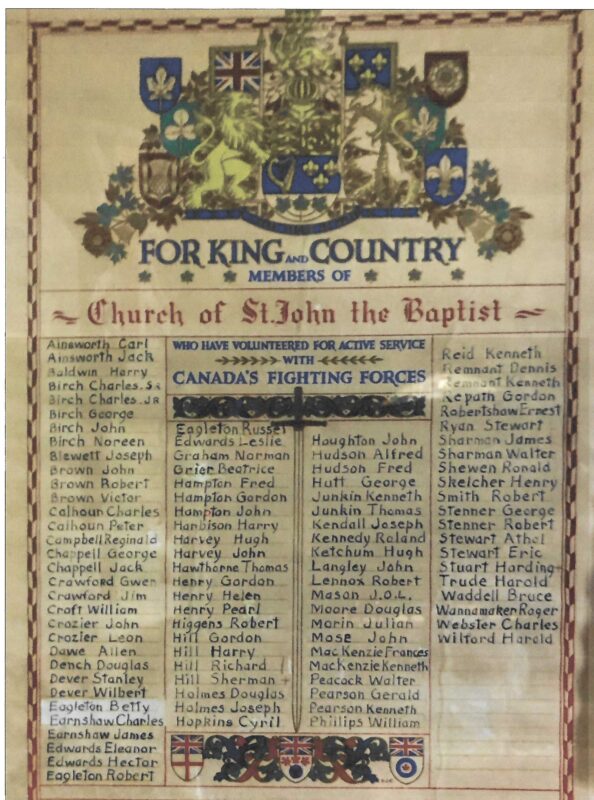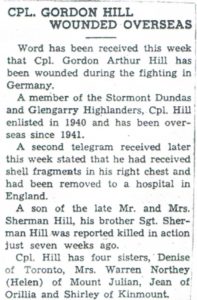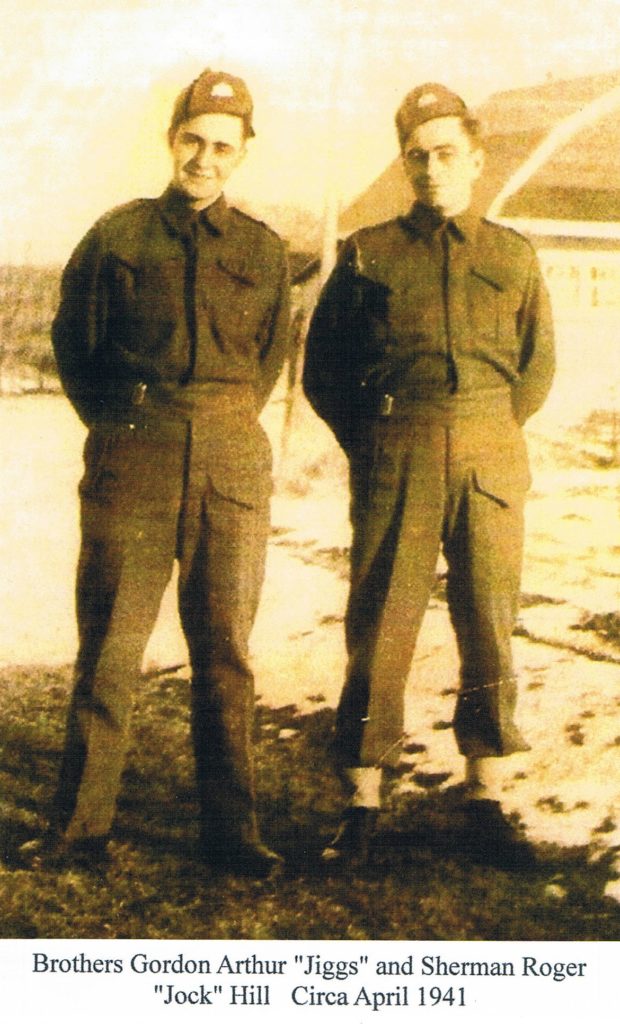
MILITARY HISTORY
Corporal Gordon Arthur Hill – C 53953 — ACTIVE SERVICE (World War II)
Gordon Arthur Hill was 20* years, 6 months and 8 days old when, as a single man, he enlisted in Peterborough, Ontario on November 20, 1940 with the Stormont, Dundas and Glengarry Highlanders (SD&GH), Active Force (AF). Gordon Arthur stated that he was born in Lakefield, Ontario on May 12, 1920* and indicated that he had no previous military experience. His previous employment was listed as a labourer at the Robertson Construction Company, Peterborough, Ontario. Gordon Arthur was 5′ 10″ tall, blue eyes, had dark brown hair and weighed 165 pounds. He lived in Lakefield, Ontario and his next-of-kin was listed as Denise Hill, his sister, living in Lakefield Ontario. Gordon Arthur Hill was assigned the rank of Private (Pte) and Service Number C 53953 with the Stormont, Dundas and Glengarry Highlanders, Active Force – Canadian Infantry Corps. *Gordon Arthur actual date-of-birth is May 12, 1922; he was actually 18 years old.
November 20, 1940 Pte Hill was taken-on-strength with the Stormont, Dundas and Glengarry Highlanders (SD&GH) in Ottawa, Ontario. The next 2 months he was employed doing Section work and would have also been doing Basic Training. On January 18, 1941 Pte Hill was posted to No 1 Company (Coy) where he would have continued with Advanced Infantry Training which would include marching, military organizations, rifles and machine guns, grenades, mortars, rocket launchers, defensive and offensive tactics, etcetera plus Military Law. Sometime before March 16, 1941 Pte Hill was posted from Ottawa to Debert, Nova Scotia. On March 16, 1941 he was admitted to the Debert Military Hospital; diagnoses is not given. March 25, 1941 Pte Hill was discharged from the Debert Military Hospital and returned to his Unit. On May 16, 1941 he was granted a 14-day Furlough to May 29, 1941.
After two more months of training, on July 21, 1941, Pte Hill was struck-off-strength from the Canadian Army (Canada) on embarking from Halifax, Nova Scotia. July 22, 1941 he was taken-on-strength with the Canadian Army (Overseas). July 31, 1941 Pte Hill disembarked at Avonmouth, England and proceeded to the SD&GH at Aldershot. After about 3½ months of training and doing assigned duties, November 13, 1941 he was granted his 1st Privilege Leave for one week with a Travel Warrant to November 20, 1941. January 15, 1942 Pte Hill is attached to the RAF Station for rations. After about another month of training and doing assigned duties, Pte Hill was granted his 2nd Privilege Leave for one week from February 10 to 16, 1942 with Rations and a Travel Warrant. February 23, 1942 his attachment to the RAF Station for rations ceases. About 3 months later, on May 14, 1942 he was granted Privilege Leave for one week to May 20, 1942. On May 31, 1942 he was admitted to No 14 Field Ambulance and discharged the next day, June 1, 1942.
June 18, 1942 Pte Hill proceeded on Special Advanced Leader Course (ALC) training with the 3rd Canadian Division. On July 22, 1942 Pte Hill returned to his Unit from the ALC training. On July 24, 1942 he was appointed as an Acting/Lance/Corporal (A/L/Cpl). August 14, 1942 A/L/Cpl Hill was granted Privilege Leave for one week to August 20, 1942. Then, on August 30, 1942 he again proceeded on Special Advanced Leader Course (ALC) training with the 3rd Canadian Division, Support Company Royal Canadian Army Service Corps (Sup Coy RCASC) for training until September 6, 1942. A/L/Cpl Hill served throughout as a Rifleman; he was also a Platoon Non-Commissioned Officer (NCO) for 3 years and 5 months. He served for 1 year, 4 months in the Theatre-of-Operations.
A/L/Cpl Hill returned to the SD&GH, in the Field, on September 7, 1942. For the next four months he would have been on lots of training and tasked with duties commensurate with his rank. November 14, 1942 A/L/Cpl Hill was granted 8 days Privilege Leave to November 21, 1942. On December 13, 1942 he was admitted to No 23 Field Ambulance for one day only. December 14, 1942 A/L/Cpl Hill was appointed to the rank of Lance Corporal (L/Cpl). Then on December 19, 1942 L/Cpl Hill was appointed to the rank of Acting Corporal (A/Cpl).
February 24, 1943 A/Cpl Hill was granted a 72-hour (3-day) Leave Pass. On March 18, 1943 he was granted 7 days Privilege Leave to March 24, 1943. Then, on March 26, 1943 A/Cpl Hill was reverted in rank to L/Cpl on his own request. The next 3 months have no notations as to what was transpiring with L/Cpl Hill. It can be assumed that he was involved with Advanced Training and many duties in preparation for an eventual move to Europe and the Front. June 10, 1943 L/Cpl Hill was granted 7 days Privilege Leave to June 16, 1943. August 8, 1943 L/Cpl Hill proceeded to the Canadian Military Headquarters (CMHQ) Course 320 Serial 37 (Platoon Weapons) and is attached for all purposes to the E & SE Army Weapons School until September 4, 1943. September 4, 1943, having completed the CMHQ 320 Serial 37 Course, L/Cpl Hill qualified “Q2”.
January 15, 1944 L/Cpl Hill was awarded the Canadian Volunteer Service Medal and Clasp. On February 21, 1944 he was admitted to No 23 Canadian Field Ambulance (CFA); his records don’t indicate when he was discharged from No 23 CFA. After about 3½ more months of training in England, on June 4, 1944 L/Cpl Hill embarked England with the SD&GH for France, he disembarked France on June 6, 1944 – D-Day.
L/Cpl Hill, being a member of the SD&GH would have been in the 9th Canadian Infantry group who landed at Juno Beach on D-Day. The following is an explanation of the Normandy invasion.
NORMANDY LANDINGS
The Normandy landings, codenamed Operation Neptune, were the landing operations of the Allied invasion of Normandy, in Operation Overlord, during World War II. The landings commenced on Tuesday, 6 June 1944
(D-Day), beginning at 6:30 am British Double Summer Time (GMT+2). In planning, as for most Allied operations, the term D-Day was used for the day of the actual landing, which was dependent on final approval.
The landings were conducted in two phases: an airborne assault landing of 24,000 British, American, Canadian and Free French airborne troops shortly after midnight, and an amphibious landing of Allied infantry and armoured divisions on the coast of France starting at 6:30 am. Surprise was achieved thanks to inclement weather and a comprehensive deception plan implemented in the months before the landings, Operation Bodyguard, to distract German attention from the possibility of landings in Normandy. A key success was to convince Adolf Hitler that the landings would actually occur to the north at the Pas-de-Calais. There were also decoy operations taking place simultaneously with the landings under the codenames Operation Glimmer and Operation Taxable to distract the German forces from the real landing areas.
The Supreme Commander of the Allied Expeditionary Forces was General Dwight Eisenhower while overall command of ground forces (21st Army Group) was given to General Bernard Montgomery. The operation, planned by a team under Lieutenant-General Frederick Morgan, was the largest amphibious invasion in world history and was executed by land, sea and air elements under direct British-American command with over 160,000 soldiers landing on 6 June 1944: 73,000 Americans, 61,715 British and 21,400 Canadians. 195,700 Allied naval and merchant navy personnel in over 5,000 ships were also involved. The invasion required the transport of soldiers and materiel from the United Kingdom by troop-laden aircraft and ships, the assault landings, air support, naval interdiction of the English Channel and naval fire-support. The landings took place along a 50-mile (80 km) stretch of the Normandy coast divided into five sectors: Utah, Omaha, Gold, Juno, and Sword.
Juno Beach — 3rd Canadian Division
[A Division usually consists of 10,000 to 30,000 troops; about 21,000 in this case]
Commanding Officer – Major-General Rodney Frederick Leopold Keller
D-Day — Order of Battle
Units of the Royal Canadian Infantry Corps
7th Canadian Infantry Brigade
8th Canadian Infantry Brigade
9th Canadian Infantry Brigade Includes the Stormont, Dundas & Glengarry Highlanders
Commanded by Lt. Colonel G. H. Christiansen
Additional Units
2nd Canadian Armoured
Royal Canadian Artillery
Royal Canadian Engineers
102 Beach Sub-Area
4th Special Service Brigade
(see JUNO BEACH – OPERATION OVERLORD which follows) The Stormont, Dundas & Glengarry Highlanders landed in Normandy on D-Day and was the first Regiment to enter Caen, reaching the centre of the city at 1300 hours, July 9, 1944.
June 14, 1944 L/Cpl Hill was appointed to A/Cpl. Over the next two months A/Cpl Hill was with his Unit and would have been deployed in action while advancing through Juno Beach and onward. On August 22, 1944 A/Cpl Hill was struck-off-strength to the X-3 List (evacuated on medical grounds). August 23, 1944 he was taken-on-strength to the X-3 List from the SD&GH. August 27, 1944 A/Cpl Hill was posted to the X-4 List (unposted reinforcements in theatre of War) [10th Bn]. Then, on August 28, 1944 A/Cpl Hill was struck-off-strength to the SD&GH and taken-on-strength from the X-4 List (10th Bn) August 29, 1944. September 14, 1944 A/Cpl Hill assigned the rank of Corporal (Cpl).
January 4, 1945 Cpl Hill was granted 9 days Privilege Leave to January 12, 1945. On March 25, 1944 he was wounded and admitted to No 88 Canadian General Hospital (CGH). Also on March 25, 1945 A/Cpl Hill was struck-off-strength to the X-3 List from the SD&GH and then admitted to No 8 CGH. March 26, 1945 he was taken-on-strength to the X-4 List from the SD&GH and transferred to No 29 British General Hospital (BGH). On April 23, 1945 Cpl Hill was discharged from No 29 BGH and on April 24, 1945 he was posted to the X-4 List (10th Bn). May 25, 1945 Cpl Hill was struck-off-strength to the SD&GH and the next day, August 26, 1945 he was taken-on-strength to the SD&GH from the X-4 List (10th Bn).
August 20, 1945 Cpl Hill was struck-off-strength to 365 Convalescent Detachment (CD) Manning Depot (MD) No 3 and on August 21, 1945 he was taken-on-strength with 365 CD MD No 3 from the SD&GH. At this point Cpl Hill was awarded the France and Germany Star; the 1939 – 1945 Star and the Defence Medal. August 25, 1945 he was struck-off-strength to the No 3 Repatriation Depot and August 26, 1945 Cpl Hill was taken-on-strength to the No 3 Repatriation Depot from 365 CD MD No 3. Although not noted, he probably embarked France and disembarked England on February 26, 1945. September 20, 1945 he was struck-off-strength to No 1 Canadian Repatriation Depot on admittance to No 22 Canadian General Hospital (CGH).
October 15, 1945 Cpl Hill was struck-off-strength from the Canadian Army (Overseas) and No 1 Canadian Reception Depot (CRD) on embarkation from England. October 16, 1945 he was taken-on-strength to the Canadian Army (Canada), S 8 Canadian Army Trades School (CATS) Hamilton, Ontario from the Canadian Army (Overseas) and No 1 CRD. Cpl Hill disembarked at Halifax, Nova Scotia October 23, 1945 and was granted Disembarkation Leave with Ration Allowance (0.50 cents per diem) from October 24, 1945 to November 22, 1945. November 27, 1945 Cpl Hill was struck-off-strength from S 8 CATS to No 2 District Depot (DD), Toronto Ontario. November 28 he was taken-on-strength to Rehabilitation Wing, No 2 DD from S 8 CATS, Hamilton. On November 30, 1945 Cpl Hill was struck-off-strength from the Canadian Army. He was granted a Clothing Allowance of $100.00 and his Rehabilitation Grant was paid.
Corporal Hill was awarded the following medals:
1939 – 45 Star;
France & Germany Star;
Defence Medal;
Canadian Volunteer Service Medal with Bar; and
War Medal 1939 – 45.
He also qualified for and received War Service Badge A, Number 696045.
Gordon Arthur (Jiggs) Hill served for 4 years, 3 months; 8 months in Canada, 2 years 11 months in the United Kingdom and 8 months in France – Germany. During his time in the Service he allotted $20.00 per month of his pay to his sister Phillis Denise.
An excerpt from an article in McLean’s magazine by Barbara Amiel, September 1996:
The military is the single calling in the world with job specifications that include a commitment to die for your nation. What could be more honorable?
Copied from a clipping from the Peterborough Examiner; Circa March 29, 1944:
CPL. GORDON HILL WOUNDED OVERSEAS
Word has been received this week that Cpl Gordon Arthur Hill has been wounded during the fighting in Germany.
A member of the Stormont Dundas and Glengarry Highlanders, Cpl Hill enlisted In 1940 and has been overseas since 1941.
A second telegram received later this week stated that he had received shell fragments in his right chest and had been removed to a hospital in England.
A son of the late Mr. and Mrs. Sherman Hill, his brother Sgt. Sherman (Roger) Hill was reported killed in action just seven weeks ago.
Cpl. Hill has four sisters, Denise of Toronto, Mrs. Warren Northey (Helen) of Mount Julian, Jean of Orillia and Shirley of Kinmount.
Obituary copied from a clipping from the Peterborough Examiner; Thursday, April 20, 2000:
Gordon Arthur (Jiggs) Hill – (1922-2000) – On May 12, 1922, Gordon Arthur Hill was born in Peterborough, son of the late Sherman Ernest Hill and Maude Udey and was raised and educated in Lakefield. Jiggs worked first for the Lakefield Dairy and on dairy farms. Later he worked for Kingdon Lumber until the War broke out. Jiggs served in the Army for five years and was discharged as a Corporal. When he returned to live in Lakefield, he worked for Canadian General Electric as a machine operator. On May 1, 1948, Jiggs married Grace Florence Huddlestone. From 1959 to 1985, the lived in Woodview and then moved to their present home on the Lakefield Road. After 37 years with CGE, Jiggs retired.
Jiggs loved to be near his family, especially his grandchildren and later his great grandchildren. When he was younger, he played some hockey, and also played the guitar. Over the years, Jiggs enjoyed hunting and fishing at the Nubs Hunt Club. He also enjoyed playing cards, reading political articles, collecting coins and listening to country music. Jiggs could often be seen at the Commercial with his Coffee Shop Club, solving all the problems in the world. He had been a member of the Lakefield Legion and was a volunteer firefighter in Woodview.
Jiggs died at his residence on Saturday, April 22, 2000. Survived by his wife Grace; sons Douglas (Lynda), Dwight (Valerie) and Tim (Traey); daughters Sharon (Gary Wrightman) and Shirley (Brian); sisters Helen Northey and Shirley Robinson; 12 grandchildren and seven great grandchildren. Predeceased by his parents Sherman and Maude Hill; brother Sherman; sisters Deniese McKenzie and Jeanne.
A Legion Service was held at the Hendren Funeral Home. His funeral was at St. John the Baptist Anglican Church, the Reverend Peter Bishop officiating. Interment was at Lakefield Cemetery. Memorial donations to the Canadian Cancer Society, or the Heart & Stroke Foundation would be appreciated.
PERSONAL HISTORY
GORDON ARTHUR HILL
Gordon Arthur was born May 12, 1922 in Lakefield Ontario to Sherman Ernest Hill and Maude Margaret Udey. He was called Gordon, but most always called “Jiggs”, by the Lakefield people who knew him.
His father died on the job December 24, 1926 when Jiggs was 7 years old; his mother passed away April 11, 1939.
Jiggs completed Grade 8, in Lakefield, at 14 years old; he then left school to go to work.
Jiggs worked at the following occupations: 1935 – 1936 he did limited mixed-fanning on Mr. A. Calder’s farm in Warsaw, Ontario for about 1 year; his salary was $10.00 per week. 1937 – 1939 Jiggs worked as a labourer in Mr. Orville E. Kingdon’s Barrel Factory (wood heading) in Lakefield, Ontario for about 2 years; his salary was $13.00 per week. In 1939 he work as a labourer, in building construction, with the Robertson Company in Peterborough, Ontario for about 2 months; his salary was $20.00 per week. In addition to the above Jiggs did other work such as some as a lumberjack in the Winter season.
Jiggs was living with his sisters in Lakefield and named Phyllis Denise (the eldest) as a dependent when he enlisted. He made a pay allotment of $20.00 per month to Denise as a Dependent’s Allowance.
Jiggs enjoyed the sports of hunting, fishing, skating and hockey; his hobby was woodworking.
Gordon Arthur married Grace Florence Huddlestone on May 1, 1948 in Lakefield, Ontario. Jiggs & Grace had five children: twins Sharon Doreen, married Alexander Earl Webster, then Gary Walter Wrightman & Shirley Lorraine, married Wayne Ireland, then Brian Thomas Ian McIntosh, Douglas Arthur, married Susan Calberry, Ronald Dwight married Valerie Marie MacNaughton and Timothy Kirk married Tracey Fletcher.
In preparation for civilian after being discharged Jiggs stated that he will seek employment in a Lumber Camp but he would like work as a mechanic. However, he found work at Canadian General Electric as a machine operator and retired after a 37-year career.
He indicated that he would use his Rehabilitation Grant as credit to buy a house.
Gordon Arthur “Jiggs” enlisted in the Canadian Army in Peterborough, Ontario on November 20, 1940 with the Stormont, Dundas and Glengarry Highlanders at the same time as his brother Sherman Roger “Jock” enlisted. They embarked from Halifax, Nova Scotia on the same ship and went into the D-Day Battle the same day. It is most likely that their paths crossed more than once during the War.
Gordon Arthur “Jiggs” Hill passed away at his residence on April 22, 2000 and is buried in Lakefield Cemetery.
THE GORDON ARTHUR HILL FAMILY OF LAKEFIELD
Gordon Arthur’s great-grandfather, Richard Hill, born about 1820 in England, died February 7, 1902 at 7 S. Bridge St., Lakefield. Richard married Elizabeth Langstaff, born about 1823, in England, died December 17, 1902 at 7 S. Bridge St., Lakefield. They married about 1842 in Canada, possibly in Dummer Township, Peterborough County, Ontario. Richard and Elizabeth had 10 children, 6 boys and 4 girls; Thomas Richard – born February 14, 1843, George Ulysses – born about 1852, Sarah – born about 1855, Samuel Alexander born about 1857, Jane T. – born about 1858, Annie – born about 1860, Roland – born about 1862, Wellington John – born April 15, 1864, Albert – born about 1868, and Ellen – born about 1874. Both Richard & Elizabeth are interred in Hillside Cemetery, Lakefield.
Gordon Arthur’s grandfather, Wellington John Hill, born April 15, 1864 in Dummer Township, Peterborough County married Rachel Ellen (Nellie) Crowe, born August 4, 1864, in Dummer Township, Peterborough County on October 1, 1886 in Lakefield Ontario. Wellington died March 12, 1942 in Lakefield Ontario, buried in Lakefield Cemetery. Nellie died June 25, 1940, in Lakefield Ontario, buried in Lakefield Cemetery.
Wellington and Nellie Hill had 8 children, seven boys and one girl;
Roland Wellington was born on May 28, 1886 in Lakefield Ontario and he married Florence Lillian Sanderson on October 14, 1914 in Peterborough Ontario. He died March 7, 1961 in Lakefield Ontario and Florence died July 4, 1987 in St. Joseph’s Hospital, Peterborough Ontario, both are buried in Lakefield Cemetery.Sherman Ernest, born September 13, 1890 in Lakefield Ontario and he married Maude Margaret Udey* on August 14, 1915.
Francis Bruce “Frank”, born September 11, 1893 and he married Lucinda Freeburn on November 8, 1916 and she was born June 25, 1897 in Smith Township on November 8, 1916 in Young’s Point Ontario.
Joseph Richard was born March 31, 1895 in Lakefield Ontario and died June 18, 1955 in Peterborough Ontario, buried in Lakefield Cemetery.
Percivale Claude, born June 6, 1897 in Lakefield Ontario and married Esther Ann Marsden, born December 2, 1902 in Ainwick Township, Ontario. He died July 14, 1971 in St. Joseph’s Hospital, Peterborough Ontario, buried in Lakefield Cemetery.
Darcy Deyncourt, born June 3, 1902 in Lakefield Ontario.
Eva Helen was born April 27, 1904 in Lakefield Ontario and married Melville Orville Kingdon about 1946, he was born November 28, 1906 in Peterborough Ontario. She died September 25, 1945 in St. Joseph’s Hospital, Peterborough Ontario, buried in Lakefield Cemetery. He died November 17, 1972 in Peterborough Ontario, buried in Lakefield Cemetery.
Harry Travers was born November 6, 1906 in St. Joseph’s Hospital, Peterborough Ontario and he married Eva Violeta Hendren in 1948, born December 9, 1913. He died May 5, 1975 in St. Joseph’s Hospital, Peterborough Ontario, buried May 7, 1975 in Lakefield Cemetery. She died October 30, 2008 in Extendicare Lakefield, Lakefield Ontario, buried November 3, 2008 in Lakefield Cemetery.
* Maude Margaret Udey married a “Connelly after Sherman Ernest Hill’s demise since Sherman Roger’s Military File indicates a “Shirley Patricia Connelly”, born about 1932, as a step-child.
Gordon Arthur’s father, Sherman Ernest Hill, married Maude Margaret Udey*, daughter of William Udey and Laura Billings, was born in Neligh Nebraska- USA, August 14, 1915. Both lived in Lakefield Ontario. They had five children: Sherman Roger, born April 3, 1916; Phyllis Denise, born October 5, 1920; Gordon Arthur “Jiggs”, born May 12, 1922; Jeanne, born March 2, 1924 and Helen H., born February 13, 1927.
Gordon Arthur “Jiggs” Hill Victor Andre Brown is remembered and honoured on a framed document that hangs in St. John the Baptist Anglican Church in Lakefield Ontario.



